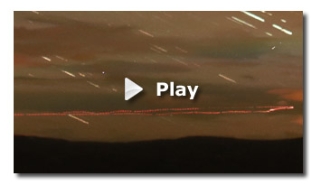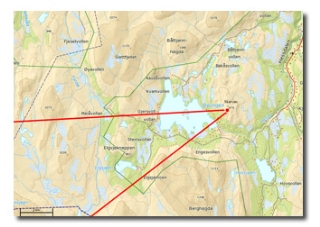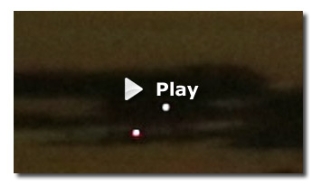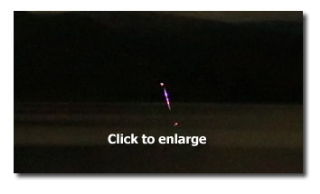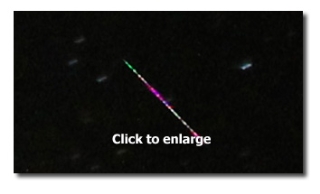Photo sequence of a red light manouvering in Hessdalen - Hessdalen Germany
Main menu
Photo sequence of a red light manouvering in Hessdalen
September 2012
The Science Camp 2012 has been organized by Bjørn Gitle Hauge and Erling Strand in cooperation with the Inspira Science Center. Beside two groups of pupils with special interest in natural science, three TV crews and amateur researcher from five countries came to Hessdalen. During the five day research period, numerous photographs, measurements and observation could be obtained. Below the images of Bernd Pröschold and Jader Monari are displayed. Thanks a lot to the Italien scientists, who provided some images for Hessdalen Germany.
Already in the first night of the Science Camp a red blinking light was captured in a timelapse sequence, moving west of lake Øyungen for 55 minutes. The light is showing some side motion and is performing three 180° turns.
The exposure time of the single exposures was 15 seconds. The intervall between two exposures was one second. The startrails on the composite images, consisting out of ca. 35 photos, are appearing bumpy for this reason and the path of the light is interrupted periodically. During the 15-
The characteristics of the light are differing from aiplanes in several regards:
1. Position lights of airplanes are displayed as straight lines in longtime exposures and don´t show side movements.
2. According to IATA provisions air planes and helicopters have not only to use a red light but also a white and a green light. White lights in the photos are caused by overexposure.
3. Air planes are flying with constant speed and are not able to stop (see timecode 00:59 in the video).
4. Ordinary microcopters or drones are not able to operate for 55min at a windspeed of 5 bft.
5. The analysis of more than 10,000 (!) nightsky shots of airplane lights revealed not a single comparable photograph. The analysis has been using raw material from the sternstunden footage library.
The bizzare flight pass of the light is becoming visible on composite photographs, consisting of 35 photos:
22:01 -
22:28 -
For an ideal display please deactivate the automatic image size adjustment of your browser.
Timelapse sequence of a red light in the west of lake Øyungen. The pictures have been taken with a Canon EOS 5DIII with 24mm lens and a spectral filter foil (Exp. time 15sec, intervall 1sec, 5000 Asa, f2, before 21:49: f7). The shooting location is Skarvan hill (62°45´30´´north, 11°06´15´´east). Strong western winds prevented a contious visual observation of the lake during the night.
Timelapse shot of the "maneuver" of the light covering 55 minutes. The spectrum visible in the shots is originating from a cabin at the eastern shore of the lake. The light in question is too weak to produce a spectrum. The pointlike structure of the stars is due to the 1sec gap between the exposures. The pointlike structure of the light appears within a single 15 sec exposure and must have been caused by a pulsation of the light.
Map, showing the position of the camera on Skarvan hill and the field of view of the images.
In the same night at 2:00 another light appears in front of an uninhabited islands in the middle of the lake. 16 minutes later it reappears at nearly the same position. What can be seen in the images are probably two very short pointlike flahes -
The pictures have been taken with a Canon EOS 5DIII with 24mm lens and spectral foil (Exp. time15sec, intervall 1sec, 5000 Asa, f2). The light at the western shore of the lake is a cabin light.
During the night from September 19th to 20th the Northern Lights have been very active. The Italian group of scientists around Jader Monari went to Vista Point at the northern end of the valley to take pictures of this event. But the images are not just showing the Northern Lights but also a strange light phenomenon. Special thanks to Jader Monari for providing his images.
Update: According to the analysis of a similar image taken in 2013, it is reasonalbe to assume that the camera has been shaken and that the photo is just showing blurred stars.
Although the light behaved quite strange, it has not been spotted visually.
In the last night of the Science Camp Bernd Pröschold has chosen the western shore of lake Øyungen as shooting location for his timelapse shots. At 02:05 CEST the camera is showing an unusual phenomenon. Update: Probably the exposure is showing an artefact caused by myons. Myons emerge when cosmic radiation is hitting the upper atmosphere. The impact is causing particle cascades. When myons hit the image sensor, entire chains of pixels can be ionized. According artefact are regularly appearing in longtime exposures. However, it might be possible that such kind of artefacts are more frequently observed in Hessdalen than elsewhere -
You are looking on an enlarged cutout of the original image. The picture has been taken with a Canon EOS 5DIII, a 14-
In the night from Friday to Saturday after the official end of the Science Camp, the Italian research group around Jader Monari found another interesting structure in their images. The picture was taken at the basecamp near the eastern shore of Øyungen lake. Update: Probably the exposure is showing an artefact caused by myons. Myons emerge when cosmic radiation is hitting the upper atmosphere. The impact is causing particle cascades. When myons hit the image sensor, entire chains of pixels can be ionized. According artefact are regularly appearing in longtime exposures. However, it might be possible that such kind of artefacts are more frequently observed in Hessdalen than elsewhere -
The picture has been taken with a Canon 20DA and Samyang 8mm lens with 15 seconds exposure time at 1600 Asa.

